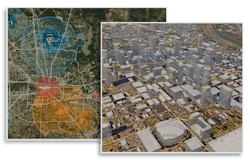By: Mike Danielak
There’s no way around it—infrastructure inspection is as risky and dangerous as it is vital. According to OSHA, sending workers up towers or on top of roofs contributes to falls, the leading cause of death among construction workers. Helicopters can be a fast way to inspect a pipeline or transmission line, but they pose a certain amount of risk as well. For the past few years, companies have begun experimenting with unmanned aerial systems (UAS, or drones) to help improve worker safety, among other benefits. For starters, drones enable people to work at height less often, and often the risks of helicopters can be eliminated altogether. Keeping workers safe is reason enough—but drones can also help to identify structural weaknesses more quickly than those older, riskier methods.
This article outlines some of the key ways that companies are using drones to more safely maintain infrastructure such as bridges, roads, oil and gas pipelines, transmission lines, and more.
Working at height isn’t the only risk inspectors face. They may also come into contact with toxic chemicals or emissions, moving machinery, and speeding traffic or high-voltage equipment. These risks multiply when the asset is in disrepair.
Drones make it possible for workers to survey structures from the ground and at a safe distance. As the FAA grants more waivers to enable flights beyond visual line of sight (BVLOS), field workers will be able to rely on drones to inspect gas pipelines and power lines, reducing the miles they have to drive on poorly maintained back roads.
“Many of the things we’ve done in traditional ways have required manned helicopters, humans climbing things, or our people getting in harm’s way to do inspections or routine maintenance,” said Harry Nuttall, director of system air for Southern Company, the Atlanta-based energy company with natural gas, electric, and other business operations across 19 states. “Putting an unmanned system in there really enhances safety and efficiency.”
Drones are especially valuable following disasters, when damaged infrastructure systems need immediate assessment, but conditions are still hazardous. Drone pilots using platforms like Skyward can launch within minutes using the FAA’s automated LAANC approval process. They can also see temporary flight restrictions and coordinate safe flights with colleagues who may also be flying drones or other aircraft in the area.
Here are some of the types of infrastructure inspections that are becoming dramatically safer with UAS.
Oil and natural gas pipelines, for leak detection and equipment corrosion
Vertical structures—nuclear cooling towers, storage tanks, smokestacks, piers, and the like—to look for signs of wear and anomalies
Dams and levees, to identify structural defects and needed repairs, and assure environmental compliance/avoid stopwork claims during replacement work
Bridges, underpasses, overpasses and culverts, for cracks, wear, general conditions
Roads and freeways, to assess cracking and maintenance needs of pavement
Municipal water systems—aqueducts, fish ladders on older dams, reservoirs—for leak detection, environmental monitoring, vegetation management, equipment maintenance, and security
Railways, to check for wear, vegetation, rocks, and security on tracks, as well as conditions of bridges, poles, and yards
Utility-scale solar facilities, for locating sub-performing arrays and repair needs
Onshore and offshore wind turbines, to detect cracks and other maintenance needs
Emergency, post-weather-event, and post-disaster damage assessments of all of the above
Drones are playing an increasingly important role in improving the reliability of the water, energy, and transportation systems we all rely on. Because drones enable infrastructure managers both to inspect more frequently and to obtain better data, they provide more timely understanding of what needs attention.
Drones also help public agencies, utilities, and companies that own or manage infrastructure systems to mitigate corporate risk. By keeping the field force out of harm’s way, drones curtail injuries and the lost work hours that come with them. Medical insurance, workers compensation insurance, and liability insurance expenses can also be reduced as the safety record improves. Better data reporting and improved compliance with environmental regulations bring still more risk-abatement benefits.
We know many U.S. bridges, dams, highways, energy, and water systems have exceeded their expected lifespans. But not everything is on the brink of collapse. American infrastructure remains among the world’s best. It is likely much of the fragility can be remedied before they cause widespread economic disruption. For example, a Reuters analysis found that, while about 9% of highway bridges were structurally deficient in 2017, only 4% of bridges carrying significant traffic were.
The scope of inspection is vast—100,000 miles of levees, 14,000 dams, 170,000 miles of railroad tracks, and 2.6 million miles of oil and gas pipelines. Speed and prioritization are key. UAS technology is proving to be an excellent—and much safer—tool for the job. With the coming of 5G, we can expect to see connected drones conducting BVLOS inspections autonomously, further accelerating this crucial work.
About The Author: Danielak is director of client strategy and business development at Skyward.
